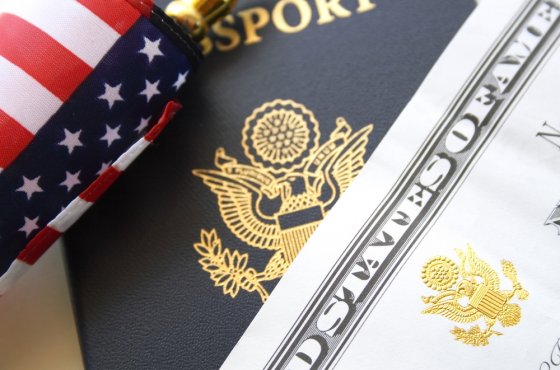A Russian went on a hunger strike in an immigration prison in Texas: he does not want to be deported to his homeland
A Russian immigrant arrested near San Antonio is on a hunger strike for fear of being deported to his homeland, reports Atmore.

Photo: IStock
The man is among a handful of Russian migrants who fled Russia and sought asylum in the United States ahead of Russian President Putin's invasion of Ukraine.
Federal officials have not disclosed how or when the migrant ended up in immigration detention or when he began his hunger strike. Details of his case are sealed in federal court in San Antonio, mainly because it involves medical and asylum-related information protected by privacy laws.
What is known
In mid-November, officials with U.S. Deportation Services in San Antonio asked the court for permission to subject the man to "forced medical examination, feeding and hydration."
On the subject: The Russian Foreign Ministry wants foreigners to sign a 'loyalty agreement' when entering Russia
U.S. District Judge Jason Pulliam on November 16 issued an order granting the motion. The case was heard in federal court “ex parte,” meaning neither the migrant nor his lawyer, if he had one, was informed of the application.
However, it is unclear whether officials had to resort to force-feeding the migrant through a tube inserted into his nose or forcing fluids into his body.
The immigrant is being held at the South Texas ICE Processing Center in Pearsall. The facility is operated by the private prison company GEO Group Inc.
“The decision to go on a hunger strike is a powerful and courageous act of resistance. It is also a radical decision that is not taken lightly—it is usually a last resort,” said Sophia Casini, director of community monitoring and advocacy at Freedom for Immigrants, an immigrant rights nonprofit based in Oakland, California.
“What we have seen across the country in response to peaceful hunger strikes is transfers to detention centers for force feeding. This is a violation of people's bodily autonomy that even the American Medical Association condemns,” she said.
Like the article? Support ForumDaily!?
“Immigration and Customs Enforcement (ICE) takes the health and well-being of individuals in our custody very seriously,” ICE said in a statement. “To ensure their health and safety, ICE carefully monitors the food and water intake of hunger strike detainees. “In addition, ICE explains to its detainees the negative health consequences of not eating, and they are under close medical supervision by ICE or contract doctors.”
The agency said there is one detainee at the ICE Processing Center in South Texas who is being monitored as part of hunger strike protocols. The agency did not identify the migrant or his nationality.
The agency said that although the inmate receives food, he refuses it, preferring instead to drink nutritional shakes from time to time.
A doctor may recommend involuntary treatment if "clinical examinations and laboratory results indicate that the detainee's debilitating condition puts the detainee's life or long-term health at risk," ICE said.
Courts have ruled that prisoners have the right to protest with hunger strikes, but not “to the point of causing serious bodily harm or death,” said Joe Veit, an El Paso attorney.
He added that court orders allowing force feeding are temporary and are usually reviewed every two weeks.
Veith also said some migrants were on hunger strike because they were languishing indefinitely in detention, even after an immigration judge ordered their deportation, because their home countries would not issue travel documents for their return or would not agree to accept them.
Some Russians fled to the United States to avoid participation in the war between the Russian Federation and Ukraine, which they did not support. They believed they could apply for asylum and be protected from deportation. But in March of this year, the Biden administration quietly resumed deportations to Russia.
Other cases of force feeding
Last year, an Indian immigrant went on a hunger strike while in immigration detention in El Paso to protest his lengthy detention and conditions at the facility.
Federal Judge in El Paso David C. Guaderrama granted ICE's request to force-feed, but allowed the agency to first offer the immigrant additional cocktails. The order allowed ICE to add nutrients, vitamins and electrolytes to the shakes without the migrant's knowledge if medical personnel deemed it necessary. If a migrant refused to drink the cocktails, the court allowed ICE to feed him through a tube in his nose if medical personnel deemed it necessary.
“Plaintiff (ICE) may face public scrutiny and litigation related to its alleged failure to provide adequate medical care,” the judge wrote in his original June 22, 2022 order. “Other detainees could probably do the same.” They go on hunger strikes to manipulate the staff and get various benefits and privileges. In addition, the inmate's death increases the security risk at Plaintiff's facility and poses a danger to all inmates and staff."
You may be interested in: top New York news, stories of our immigrants, and helpful tips about life in the Big Apple - read all this on ForumDaily New York.
The order was extended, but the forced feeding ended a month later, in July 2022, with the deportation of the migrant.
In January 2019, federal immigration officers at a facility in El Paso force-fed seven immigrants through plastic nasal tubes during a 74-day hunger strike. They were among nearly 30 immigrants from India and Cuba who refused to eat to protest abuse and threats of deportation from guards. They also said they were upset by the long prison sentences awaiting trial.
In April 2019, two Indian men who were among those force-fed were released after more than eight months in prison. But it took pressure from members of Congress to force ICE officials to act.
In a damning report, the American Civil Liberties Union said ICE used controversial practices for years under both the Obama and Trump administrations.
Based on more than 10 pages of previously unpublished reports obtained through public records requests, the ACLU concluded that ICE "performed coercive medical procedures on detained hunger strikers that violated ethical guidelines for medical personnel, including force-feeding, forced fluid administration, forced catheterization of urine and the use of restraints.”
Force feeding involves inserting a plastic tube through one of the prisoner's nostrils, down the prisoner's throat, and down the esophagus into the stomach.
“This can be a very painful procedure, causing suffocation, skin and tissue irritation, and, in rare cases, perforation of vital organs,” the ACLU report states. “The tube may also be misdirected and end up in the airway rather than the esophagus, potentially causing serious infections. When workers insert a tube against a person's will, they usually have to forcibly restrain the person using personal or mechanical restraints."
The American Medical Association has condemned coercive medical procedures such as force-feeding as a violation of the "fundamental ethical values of the medical profession."
“In some cases, ICE used private prison medical staff to force-feed hungry people in the detention center after nearby medical facilities refused to do so,” the report said.
In one case, at an immigration detention center in Aurora, Colorado, ICE officials were unable to find local hospital staff who would agree to force-feed a hunger striker due to ethical concerns.
ICE officers then contacted the medical staff of the facility's operator, GEO Group. They offered to force-feed the hunger striker.
As has been established in numerous lawsuits, ICE failed to consider alternatives to force-feeding, including addressing hunger strikers' basic demands for improved conditions.
According to the ACLU, in some cases, prosecutors sought and received permission to force-feed based on minimal evidence, sometimes without specific details or mention of the person they wanted to force-feed.
Read also on ForumDaily:
Woman dies from cerebral edema after drinking too much water
Subscribe to ForumDaily on Google NewsDo you want more important and interesting news about life in the USA and immigration to America? — support us donate! Also subscribe to our page Facebook. Select the “Priority in display” option and read us first. Also, don't forget to subscribe to our РєР ° РЅР ° Р »РІ Telegram and Instagram- there is a lot of interesting things there. And join thousands of readers ForumDaily New York — there you will find a lot of interesting and positive information about life in the metropolis.











